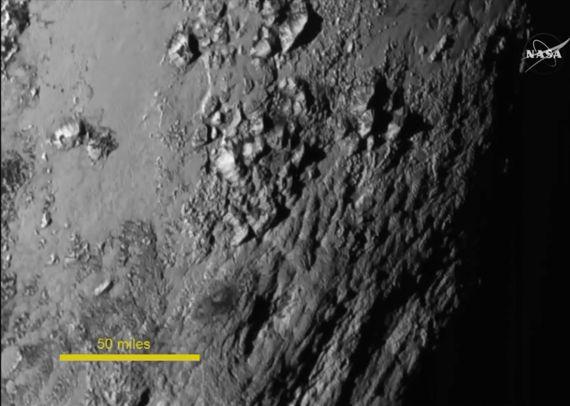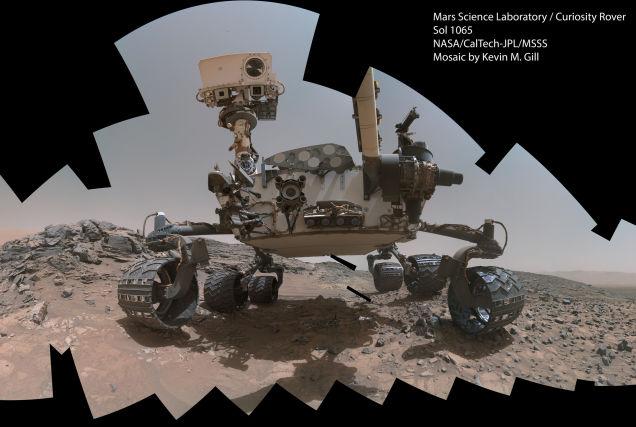Charon appears to have geological activity also. (No craters, deep trenches)
This rethink may well affect understanding of the other icey moons around the gas giants.
Results 601 to 625 of 4335
Thread: Space News thread
-
16-07-2015, 06:49 AM #601Thailand Expat


- Join Date
- Jan 2006
- Last Online
- @
- Posts
- 59,983
-
16-07-2015, 09:10 AM #602Thailand Expat



- Join Date
- Jul 2010
- Last Online
- 24-07-2024 @ 09:54 PM
- Location
- Where troubles melt like lemon drops
- Posts
- 25,350
The message from the inhabitants of Pluto was, "We are happy to see you arrive, keep on going and don't come back." They then uploaded a series of "approved" images for relaying to Earth. Originally Posted by Takeovers
Originally Posted by Takeovers
-
16-07-2015, 02:42 PM #603Thailand Expat
































- Join Date
- Nov 2008
- Last Online
- Yesterday @ 07:54 PM
- Location
- Berlin Germany
- Posts
- 7,266
Here that photo of a piece of Plutos surface that surprised the scientists so much.


This area can be at most 100 million years old or it would have many impact craters. Those mountains are ~3km high and they must be water ice. At Pluto temperatures water ice is strong and hard enough to be that high and be stable. Still completely unknown what mechanism has formed them.
One day of flyby gave enough data to keep a generation of scientists busy for decades."don't attribute to malice what can be adequately explained by incompetence"
-
18-07-2015, 02:09 PM #604Thailand Expat
































- Join Date
- Nov 2008
- Last Online
- Yesterday @ 07:54 PM
- Location
- Berlin Germany
- Posts
- 7,266
NASA is testing the RS-25 engine for use in the planned SLS launch vehicle. The RS-25 is better known as the SSME, the Space Shuttle Main Engine. Here a picture of the engine during a test fire. Note how cold it gets, especially the engine bell during firing. The white stuff on the engine bell is actually ice forming during the firing.

A rather long video of the test fire.
Last edited by Takeovers; 18-07-2015 at 02:19 PM.
-
19-07-2015, 12:32 PM #605

(Source: NASA / Johns Hopkins University Applied Physics Laboratory)
In the latest data from NASA's New Horizons spacecraft, a new close-up image of Pluto reveals a vast, craterless plain that appears to be no more than 100 million years old, and is possibly still being shaped by geologic processes. This frozen region is north of Pluto's icy mountains, in the center-left of the heart feature, informally named "Tombaugh Regio" (Tombaugh Region) after Clyde Tombaugh, who discovered Pluto in 1930.
"This terrain is not easy to explain," said Jeff Moore, leader of the New Horizons Geology, Geophysics and Imaging Team (GGI) at NASA's Ames Research Center in Moffett Field, California. "The discovery of vast, craterless, very young plains on Pluto exceeds all pre-flyby expectations."
This fascinating icy plains region -- resembling frozen mud cracks on Earth -- has been informally named "Sputnik Planum" (Sputnik Plain) after the Earth's first artificial satellite. It has a broken surface of irregularly-shaped segments, roughly 12 miles (20 kilometers) across, bordered by what appear to be shallow troughs. Some of these troughs have darker material within them, while others are traced by clumps of hills that appear to rise above the surrounding terrain. Elsewhere, the surface appears to be etched by fields of small pits that may have formed by a process called sublimation, in which ice turns directly from solid to gas, just as dry ice does on Earth.
Scientists have two working theories as to how these segments were formed. The irregular shapes may be the result of the contraction of surface materials, similar to what happens when mud dries. Alternatively, they may be a product of convection, similar to wax rising in a lava lamp. On Pluto, convection would occur within a surface layer of frozen carbon monoxide, methane and nitrogen, driven by the scant warmth of Pluto's interior.
Pluto's icy plains also display dark streaks that are a few miles long. These streaks appear to be aligned in the same direction and may have been produced by winds blowing across the frozen surface.
The Tuesday "heart of the heart" image was taken when New Horizons was 48,000 miles (77,000 kilometers) from Pluto, and shows features as small as one-half mile (1 kilometer) across. Mission scientists will learn more about these mysterious terrains from higher-resolution and stereo images that New Horizons will pull from its digital recorders and send back to Earth during the next year.
The New Horizons Atmospheres team observed Pluto's atmosphere as far as 1,000 miles (1,600 kilometers) above the surface, demonstrating that Pluto's nitrogen-rich atmosphere is quite extended. This is the first observation of Pluto's atmosphere at altitudes higher than 170 miles above the surface (270 kilometers).
The New Horizons Particles and Plasma team has discovered a region of cold, dense ionized gas tens of thousands of miles beyond Pluto -- the planet's atmosphere being stripped away by the solar wind and lost to space.
"This is just a first tantalizing look at Pluto's plasma environment," said New Horizons co-investigator Fran Bagenal, University of Colorado, Boulder.
"With the flyby in the rearview mirror, a decade-long journey to Pluto is over --but, the science payoff is only beginning," said Jim Green, director of Planetary Science at NASA Headquarters in Washington. "Data from New Horizons will continue to fuel discovery for years to come."
Alan Stern, New Horizons principal investigator from the Southwest Research Institute (SwRI), Boulder, Colorado, added, "We've only scratched the surface of our Pluto exploration, but it already seems clear to me that in the initial reconnaissance of the solar system, the best was saved for last."
New Horizons is part of NASA's New Frontiers Program, managed by the agency's Marshall Space Flight Center in Huntsville, Alabama. The Johns Hopkins University Applied Physics Laboratory in Laurel, Maryland, designed, built and operates the New Horizons spacecraft and manages the mission for NASA's Science Mission Directorate. SwRI leads the mission, science team, payload operations and encounter science planning.
Follow the New Horizons mission on Twitter and use the hashtag #PlutoFlyby to join the conversation. Live updates are also available on the mission Facebook page.
For more information on the New Horizons mission, including fact sheets, schedules, video and new images, visit:
New Horizons | NASALast edited by palexxxx; 19-07-2015 at 12:43 PM.
"The problem with quotes on the Internet is that it is hard to verify their authenticity." - Abe Lincoln.
-
28-07-2015, 09:21 AM #606
-
28-07-2015, 12:24 PM #607
You didn't know that?
He's been on The Sky at Night loads of times.
Dr. Brian May even has an Asteroid named after him courtesy of Sir Patrick Moore.
-
28-07-2015, 03:48 PM #608Custom Title Changer
































- Join Date
- Dec 2007
- Last Online
- Yesterday @ 08:25 PM
- Location
- Bangkok
- Posts
- 12,503
No, I didn't. That's frigging cool. Originally Posted by harrybarracuda
Originally Posted by harrybarracuda
-
28-07-2015, 04:06 PM #609
-
28-07-2015, 04:30 PM #610Gohills flip-flops wearer
































- Join Date
- Oct 2008
- Last Online
- 10-12-2024 @ 03:58 PM
- Location
- The Felcher Memorial Home.
- Posts
- 14,570
I reckon you posted it because you love the queen. Originally Posted by palexxxx
Originally Posted by palexxxx


-
28-07-2015, 04:40 PM #611Custom Title Changer
































- Join Date
- Dec 2007
- Last Online
- Yesterday @ 08:25 PM
- Location
- Bangkok
- Posts
- 12,503
^ you reckon she keeps a few quid tucked in her bra?
-
28-07-2015, 04:41 PM #612
-
06-08-2015, 01:01 AM #613Thailand Expat
































- Join Date
- Nov 2008
- Last Online
- Yesterday @ 07:54 PM
- Location
- Berlin Germany
- Posts
- 7,266
A gif from DSCOVR. The deep space climate observatory. The moon is passing in front of earth. What you see here is the backside of the moon we never see from earth. Note also the spot in the center of earth. It is a reflection of the sun, a highlight.

DSCOVR is placed in the Earth-Sun Lagrange Point L1. That means it is in an almost stable position between Earth and Sun and can remain there observing the sun and informing us early on any incoming sun flares. From that position it can also do very good pictures of earth - and the moon.
-
06-08-2015, 03:44 PM #614Dislocated Member
































- Join Date
- May 2011
- Last Online
- 31-10-2021 @ 03:34 AM
- Location
- Nebuchadnezzar
- Posts
- 10,609
Scientists analysing data from Philae have found organic compounds on comet 67P, that's not life but it is the building blocks of life. It strengthens the theory that life is spread throughout the universe.

Organic compounds on comet 67P/Churyumov-Gerasimenko revealed by COSAC mass spectrometryLife should not be a journey to the grave with the intention of arriving safely in a pretty and well preserved body, but rather to skid in broadside in a cloud of smoke, thoroughly used up, totally worn out, and loudly proclaiming "Wow! What a Ride!"
-
10-08-2015, 11:31 PM #615Thailand Expat
































- Join Date
- Nov 2008
- Last Online
- Yesterday @ 07:54 PM
- Location
- Berlin Germany
- Posts
- 7,266
Live on NASA TV. Red lettuce will be harvested in a few minutes. This time it is for consumption by the astronauts. The first food grown in space to be eaten in space. Previous lettuce grown in the ISS has not been consumed but sent back to earth for analysis.
-
11-08-2015, 02:13 PM #616Thailand Expat



- Join Date
- Sep 2009
- Last Online
- 18-07-2020 @ 11:25 PM
- Location
- in t' naughty lass
- Posts
- 5,525

Better watch out for them croutons - it'll turn into a mini asteroid belt!
-
12-08-2015, 02:42 AM #617Dislocated Member
































- Join Date
- May 2011
- Last Online
- 31-10-2021 @ 03:34 AM
- Location
- Nebuchadnezzar
- Posts
- 10,609

Kevin Gill’s mosaic image of NASA’s Mars rover
-
13-08-2015, 02:20 PM #618
'Impossible' propellantless engine appears to work despite breaking laws of physics
Ridiculed as impossible by the scientific community, the electromagnetic propulsion engine – which could supposedly take a craft from Earth to Pluto in just 18 months without the need for rocket fuel – has apparently been confirmed by an independent scientist as working.
German scientist Martin Tajmar, who has a history of debunking fanciful propulsion systems, claims in a paper he has tested a copy of NASA's experimental device (known as the EMDrive) and that it does produce thrust. This is controversial because the theory that has been used to explain the device violates conventional physics and the law of conservation of momentum.
The EMDrive theoretically works by converting electric power into microwaves which bounce around inside an enclosed cavity, using the difference in radiation to move through an environment. This violates the laws of physics, which state that if something moves forward it must also push something back, as no propellant is expelled to balance the engine's momentum.
http://www.theage.com.au/technology/...28-gimlhr.html
-
13-08-2015, 02:39 PM #619Thailand Expat
































- Join Date
- Nov 2008
- Last Online
- Yesterday @ 07:54 PM
- Location
- Berlin Germany
- Posts
- 7,266
I follow this for months now but was very hesitant to post it here. The scientific community and amateurs trying to copy it is really buzzing.
There is no valid theory at all on how it works, IF it works. The theories of the inventor Shawyer have been thoroughly disproven. However the effect he describes has been found by many others. If it works it may not only revolutionize spaceflight. It has the potential to change our world for everybody. But that means that extraordinary claims will need extraordinary proof. I am anxiously waiting for that.
-
14-08-2015, 02:47 PM #620Thailand Expat
































- Join Date
- Nov 2008
- Last Online
- Yesterday @ 07:54 PM
- Location
- Berlin Germany
- Posts
- 7,266
Some more on the EM-drive.
A list of the experiments done by a number of people showing their findings.
Experimental Results - EM Drive
The most scientific sound experiments were done by the NASA eagleworks group, which unfortunately has very, very low funding and the Polytechnical University Dresden, Germany. They both find unexplained forces produced by their experiments but very small, so despite their best efforts it still may be just experimental errors.
Stronger forces have been measured by the inventor Shawyer and at a research facility of a chinese University.
Shawyer leaves the impression to me as a charlatan, I may be wrong though. About the chinese effort, it is not uncommon in China to publish dodgy results to get more funding. So we don't know how far to trust their results. Intersting though that after initial openness their research goes on but they have been prohibited to publish any longer. It is anybodys guess what that might mean.
The list also contains the data of the well known VASIMR ion drive many have hopes for interplanetary travel. VASIMR is not an EM-drive but an ion drive using propellant. But it was included for comparison of efficiency.
If we believe in the chinese results the EM-drive produces 30 times the thrust per kW compared to VASIMR and that without expending propellant. If true that would be huge. It would open the inner solar system up to the asteroid belt for exploration at much reduced cost and shorter travel times.
-
14-08-2015, 03:08 PM #621Thailand Expat
































- Join Date
- Nov 2008
- Last Online
- Yesterday @ 07:54 PM
- Location
- Berlin Germany
- Posts
- 7,266
About the theory of the EM-drive. In short we just don't know. But it is quite clear it cannot be explained by present physics theory. The inventor Shawyer who claimes it can be explained with conventional physics is clearly wrong.
After reading a lot about it I got more and more sceptical. Not because of any particular facts but because if true it might be world shattering. A discovery equal to the use of fire and the invention of the wheel.
How that? People writing about EM-drive except complete nuts are very hesitant on talking about the consequences for the reasons I mentioned above.
The only theory that might explain the EM-drive effect is involvement of quantum fluctuation. As you surely know quantum vacuum fluctuation makes pairs of particles and their anti-particles appear out of nothing and shortly thereafter annihilate each other, as predicted by Heisenbergs uncertainty principle. That effect is known but so far theory says it cannot be used for anything as the net result is always ZERO.
The EM-drive may change that and make quantum fluctuation do something, resulting in an effect that produces more impulse than that accounted for by the electric power put into it. That would mean you can probably build a machine that would seem very much like a perpetual motion machine. Like building an EM-motor that consumes 100kW to drive a generator that produces 1MW. Numbers of course purely fictional just to highlight what I mean.
To believe that I need to see a very reputable institution build and test the EM-drive and then other very reputable institutions peer review and confirm the findings.
-
18-08-2015, 02:06 AM #622Thailand Expat
































- Join Date
- Nov 2008
- Last Online
- Yesterday @ 07:54 PM
- Location
- Berlin Germany
- Posts
- 7,266
A few photos taken by the Indian Mars Orbiter Chandrayaan. The pictures have been processed to show 3D pictures. Chandrayaan works remarkably well.



-
18-08-2015, 02:21 AM #623Thailand Expat































- Join Date
- Mar 2011
- Last Online
- 25-03-2021 @ 08:47 AM
- Posts
- 36,437
Looks vaguely similar to a photo of Canada from space... Originally Posted by Neo
Originally Posted by Neo
-
20-08-2015, 03:37 PM #624Watch Out. Rosetta Probe! Comet 67P Spewing Chunks! (of Ice) | VideoWatch Out. Rosetta Probe! Comet 67P Spewing Chunks! (of Ice) | Video
ESA’s Rosetta probe is keeping a sharp eye on comet 67P/Churyumov-Gerasimenko during its perihelion (closest approach to the Sun and peak activity time). The flying ice mountain’s structural integrity is most compromised now, fragmenting and blowing prominent dust jets.
Credit: ESA
-
20-08-2015, 07:08 PM #625Thailand Expat
































- Join Date
- Nov 2008
- Last Online
- Yesterday @ 07:54 PM
- Location
- Berlin Germany
- Posts
- 7,266
Lots going on in space. Exciting times for Rosetta. Also exciting times for the Dawn probe orbiting dwarf planet Ceres.
Dawn has been circling Ceres for a while now making many measurements and taking photos. A beautiful view of Ceres during a whole orbital circle and some more info in this video. It was taken from an orbit 4400km above Ceres. Now Dawn has moved down to a lower orbit at 1470km. This will allow another survey at greater resolution. But soon, planned for December, it will get down to its final orbit of 375km where it will stay permanently until end of the mission.
Thread Information
Users Browsing this Thread
There are currently 40 users browsing this thread. (0 members and 40 guests)




 Reply With Quote
Reply With Quote

